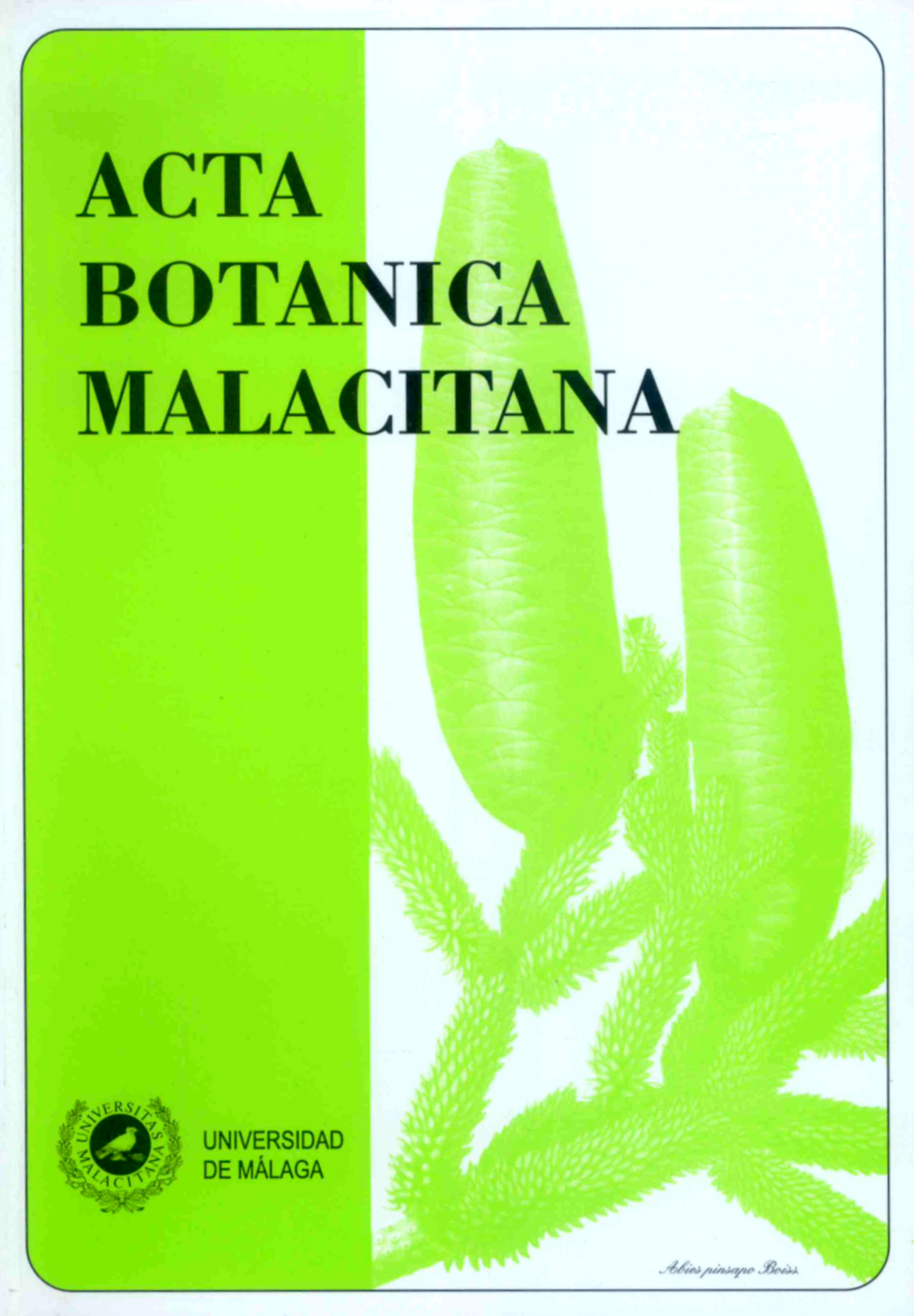La vegetación del Norte del Perú: de los bosques a la jalca en Cajamarca
DOI:
https://doi.org/10.24310/abm.v40i0.2505Resumen
Español.
El departamento de Cajamarca, en el Norte del Perú, se caracteriza en general por un clima más húmedo que el resto del territorio andino peruano occidental. Teniendo en cuenta el paralelismo entre el clima y las unidades de vegetación que ofrecen los pisos bioclimáticos, los ombrotipos, la geología y los suelos, y levantando inventarios según la metodología de Braun-Blanquet, estudiamos la vegetación de este territorio. Se describen 2 comunidades vegetales, 8 asociaciones, 3 subasociaciones, 3 alianzas, 1 orden y 1 clase fitosociológica. Como resultado, se analizan la comunidad de Cecropia montana y Heliocarpus americanus (termotropical subhúmedo-húmeda) y de Muntingia calabura y Hura crepitans (infratropical seco-subhúmeda), ambas de la clase Nectandro laevis-Licarietea canellae presente en el norte del territorio. Hacia el sur, los bosques lauroides y esclerófilos están representados por las nuevas asociaciones Axinaeo nitidae-Podocarpetum oleifolii (bosques mesotropicales, húmedo-hiperhúmedos), Verbesino auriculigerae-Siparunetum muricatae (bosques mesotropicales húmedo-hiperhúmedos de áreas alteradas), Berberido beauverdianae-Myrcianthetum myrsinoidis (bosques del piso mesotropical inferior seco-subhúmedo) y Aristeguietio discoloris-Kageneckietum lanceolatae (bosques del piso mesotropical superior seco-subhúmedo), todas agrupadas en la nueva alianza Monnino pilosae-Myrcianthion myrsinoidis (Pruno rigidae-Oreopanacetea floribundi). Las asociaciones nuevas Baccharito latifoliae-Monactinetum flaverioidis (supra-mesotropical subhúmedo-seca) y Monactino flaverioidis-Colignonietum parviflorae (mesotropical húmeda) son las arbustedas sucesionales de los bosques y se agrupan en la alianza Otholobio munyensis-Rubion robusti all. nova y en la nueva clase andina Clematido peruvianae-Baccharitetea latifoliae. Se describen dos nuevas asociaciones de los pajonales del páramo (“jalca”) con sus subasociaciones: Calamagrostio tarmensis-Hypericetum laricifolii (pajonales supratropicales húmedos del sector Chota-Contumazá), con la subasociación cortaderietosum nitidae en áreas rocosas, y Agrostio tolucensis-Paspaletum bonplandiani (pajonales orotropicales húmedos-hiperhúmedos del sector Chota-Contumazá), con la subasociación puyetosum fastuosae en suelos húmedos, y calamagrostietosum curvulae como una subasociación de transición hacia los pajonales de la puna del centro del Perú. Además, hemos reconocido y lectotipificado la asociación supratropical húmeda Oreobolo goeppingieri-Hypericetum laricifolii, característica del sector biogeográfico Loja-Cutervo. Todas estas asociaciones de pastizales pertenecen a la nueva alianza Agrostio tolucensis-Paspalion bonplandiani y al nuevo orden Agrostio tolucensis-Paspaletalia bonplandiani (Calamagrostietea vicunarum). Por otra parte, presentamos un esquema sintaxonómico con todas las clases fitosociológicas estudiadas por el
momento en el departamento de Cajamarca, incluyendo bosques secos y vegetación con cactus y otras plantas suculentas (Acacio macracanthae-Prosopidetea pallidae), alisedas (Alnetea acuminatae), bosques altoandinos (Polylepidetea tarapacano-besseri), y vegetación helofítica de riveras (Tessario integrifoliae-Baccharitetea salicifoliae). Como resultado de este estudio fitosociológico comentamos la biogeografía del N del Perú estableciendo los sectores Loja-Cutervo y Chota-Contumazá, y finalmente hemos cartografiado la vegetación potencial de Cajamarca
English.
The Department of Cajamarca, in Northern Peru, is generally characterized by a more general humid climate that in the rest of the occidental Andean Peruvian territory. Taking account of the parallelism between climate and vegetation units offered by bioclimatic belts and ombrotypes, geology and soils, and making plots according to the Braun-Blanquet methodology, the vegetation of the territory was studied. Two plant communities, 8 associations, 3 subassociations, 3 alliances, 1 order and 1 phytosociological class are described. As a result, we have analyzed the Cecropia montana and Heliocarpus americanus (thermotropical subhumid-humid) and the Muntingia calabura and Hura crepitans (infratropical dry-subhumid) plant communities, both belonging to the Nectandro laevis-Licarietea canellae class in the North of the territory. To the South, laurel like and sclerophyllous forests are represented by the new associations Axinaeo nitidae-Podocarpetum oleifolii (mesotropical, humid-hyperhumid forests), Verbesino auriculigerae-Siparunetum muricatae (mesotropical humid-hyperhumid forests on disturbed areas), Berberido beauverdianae-Myrcianthetum myrsinoidis (lower mesotropical dry-subhumid forests), and Aristeguietio discoloris-Kageneckietum lanceolatae (upper mesotropical dry-subhumid forests), all grouped into the new alliance Monnino pilosae-Myrcianthion myrsinoidis (Pruno rigidae-Oreopanacetea floribundi). The supra-mesotropical, subhumid-dry Baccharito latifoliae-Monactinetum flaverioidis and the mesotropical humid Monactino flaverioidis-Colignonietum parviflorae new associations are the successional shrublands of the forests, grouped into the new alliance Otholobio munyensis-Rubion robusti and into the new Andean class Clematido peruvianae-Baccharitetea latifoliae. Two new associations for the paramo (“jalca”) grasslands have been described with their subassociations: Calamagrostio tarmensis-Hypericetum laricifolii (supratropical humid grasslands from the Chota-Contumazá biogeographical sector), with cortaderietosum nitidae subassociation on rocky areas, and Agrostio tolucensis-Paspaletum bonplandiani (orotropical humid-hyperhumid grasslands from the Chota-Contumazá biogeographical sector), with puyetosum fastuosae subassociation on humid soils, and calamagrostietosum curvulae as transitional subassociation to the puna grasslands in Central Peru. Furthermore, we have recognized and lectotypified the supratropical humid association Oreobolo goeppingieri-Hypericetum laricifolii from the Loja-Cutervo biogeographical sector. These grassland associations belong to the new alliance Agrostio tolucensis-Paspalion bonplandiani and to the new order Agrostio tolucensis-Paspaletalia bonplandiani (Calamagrostietea vicunarum class). Besides, we present a syntaxonomical scheme with all the phytosociological class studied for the moment in the Department of Cajamarca, including dry forest and succulent vegetation with cactus (Acacio macracanthae-Prosopidetea pallidae), Andean alder forests (Alnetea acuminatae), high Andean forests (Polylepidetea tarapacano-besseri), and helophytic river vegetation (Tessario integrifoliae-Baccharitetea salicifoliae).
As a result of the study of the phytosociological units of Cajamarca, we comment the biogeography of Northern Peru establishing the Loja-Cutervo and Chota-Contumazá sectors, and finally, we have maped the potential vegetation of Cajamarca.
Descargas
Métricas
Descargas
Publicado
Cómo citar
Número
Sección
Licencia
Toda la información relacionada con la licencia de uso de los trabajos publicados en Acta Botanica Malacitana y con los derechos de autor se pueden consultar en nuestra Política Editorial.








1.png)
